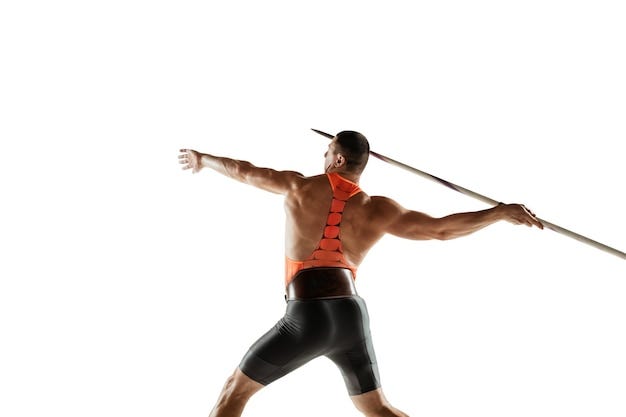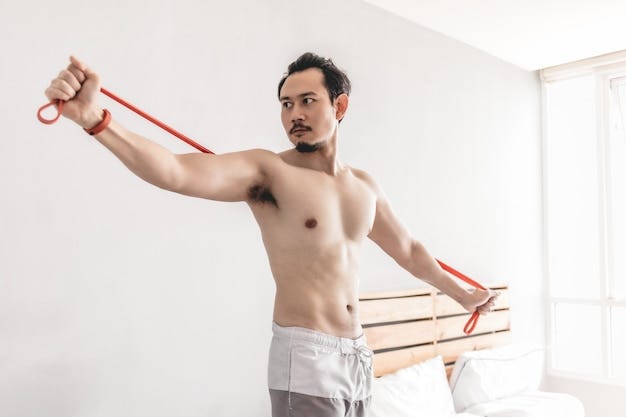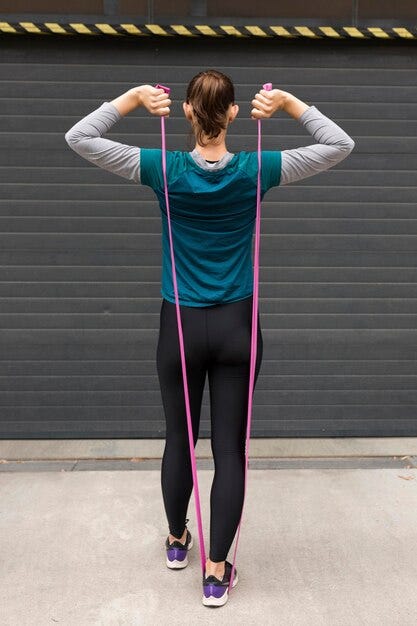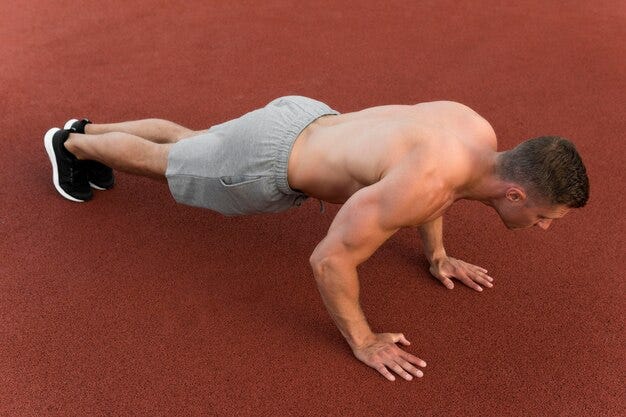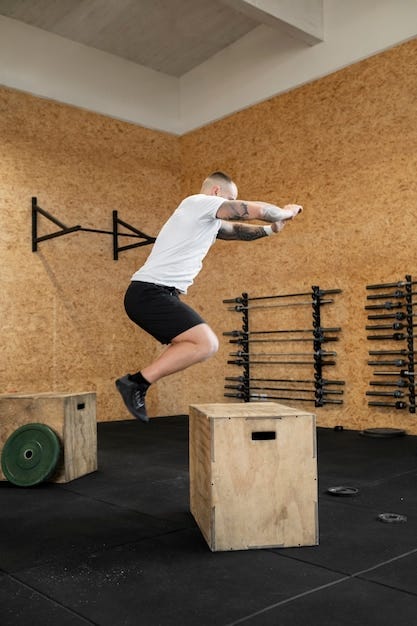Optimizing Performance and Preventing Injuries in Javelin Throw: The Role of Physiotherapy
Physiotherapy Post | Vol. 2, Issue 37 | August 2024
Dear Athletes and Enthusiasts,
Welcome to our another edition of Physiotherapy Post on Optimizing Performance and Preventing Injuries in Javelin Throw: The Role of Physiotherapy. Whether you're an aspiring javelin thrower, a seasoned athlete, a coach, or a therapist, this resource is designed to provide you with valuable insights into the critical role of physiotherapy in enhancing performance and preventing injuries.
In the demanding sport of javelin throw, maintaining peak physical condition and preventing injuries are paramount. Our aim is to equip you with the knowledge and techniques necessary to achieve these goals. From understanding common injuries specific to javelin throwers to exploring advanced physiotherapy practices, we cover it all.
We hope this guide serves as a vital tool in your athletic journey, helping you reach new heights while ensuring your well-being. Let's embark on this path to excellence together.
Warm regards,
Dr. Aditi Singh
Editor-in-chief
Physiotherapy Post
Javelin throw is a complex athletic event that demands a combination of strength, speed, coordination, and technique. Due to the high-intensity nature of the sport, athletes are prone to various injuries, particularly in the shoulder, elbow, and lower back. Physiotherapy plays a crucial role in both the prevention and rehabilitation of these injuries, ensuring athletes maintain peak performance levels.
Common Injuries in Javelin Throw
Shoulder Injuries: The shoulder joint is highly susceptible to overuse injuries due to repetitive throwing motions. Common issues include rotator cuff tendinitis, labral tears, and impingement syndrome.
Elbow Injuries: The elbow experiences significant stress during the throw, leading to conditions such as medial epicondylitis (golfer’s elbow) and ulnar collateral ligament (UCL) injuries.
Lower Back Pain: The rotational forces involved in javelin throwing can lead to lower back pain and lumbar spine injuries.
Role of Physiotherapy
Physiotherapy interventions for javelin throwers focus on injury prevention, acute injury management, and long-term rehabilitation. Here are key aspects supported by scientific evidence:
1. Injury Prevention
Strength Training: Strengthening the muscles around the shoulder girdle, core, and lower body can help distribute the forces more evenly and reduce the risk of injury. Studies have shown that targeted strength training can significantly decrease the incidence of shoulder injuries (Escamilla et al., 2009).
Flexibility Exercises: Maintaining flexibility in the shoulders, hips, and thoracic spine is crucial for optimal throwing mechanics. Stretching routines tailored to these areas can prevent muscle tightness and imbalances (Page et al., 2010).
2. Acute Injury Management
Immediate Care: For acute injuries, physiotherapists employ techniques such as cryotherapy (ice therapy), compression, and elevation to reduce inflammation and pain.
Manual Therapy: Techniques like joint mobilizations and soft tissue massage can help restore normal movement patterns and alleviate pain (Cook et al., 2012).
3. Rehabilitation
Progressive Loading: Rehabilitation programs often follow a progressive loading approach where exercises gradually increase in intensity to rebuild strength without overloading the injured tissues (Hinterwimmer et al., 2016).
Neuromuscular Re-Education: This involves retraining the muscles to work together effectively through proprioceptive exercises and dynamic stability training (Myers et al., 2006).
Sport-Specific Drills: Incorporating sport-specific drills ensures that the athlete regains not only general fitness but also the specific skills required for javelin throwing (Wilk et al., 2009).
Evidence-Based Practices
Several studies underscore the effectiveness of physiotherapy interventions for javelin throwers:
A study by Ellenbecker et al. (2010) highlighted that a structured shoulder strengthening program reduced injury rates among overhead athletes.
Research by Kibler et al. (2013) demonstrated that scapular stabilization exercises improved shoulder function and reduced pain in throwers.
A systematic review by van der Hoeven & Kibler (2006) concluded that early intervention with physiotherapy significantly improved outcomes for athletes with throwing-related injuries.
Specific Physiotherapy Exercises for Javelin Throwers
Javelin throwers require a combination of strength, flexibility, and coordination to excel in their sport. Physiotherapy exercises are crucial for enhancing performance and preventing injuries. Below are some key exercises tailored for javelin throwers:
1. Shoulder Strengthening Exercises
External Rotations with Resistance Bands: Attach a resistance band to a stable object at elbow height. Stand with the band in your hand, elbow bent at 90 degrees, and rotate your arm outward.
Internal Rotations with Resistance Bands: Similar setup as external rotations but rotate your arm inward.
Scapular Push-Ups: Perform push-ups while focusing on retracting and protracting the shoulder blades.
2. Core Stability Exercises
Planks: Maintain a plank position on your elbows and toes, keeping your body straight and engaging your core.
Russian Twists: Sit on the floor with knees bent, lean back slightly, and twist your torso from side to side while holding a weight or medicine ball.
Dead Bugs: Lie on your back with arms extended toward the ceiling and knees bent at 90 degrees. Lower one arm and the opposite leg simultaneously, then return to the starting position and repeat on the other side.
3. Lower Body Strengthening Exercises
Squats: Perform squats to build strength in the quadriceps, hamstrings, and glutes.
Lunges: Step forward into a lunge position, ensuring your knee does not go past your toes. Alternate legs.
Single-Leg Deadlifts: Stand on one leg and hinge forward at the hips while extending the other leg backward, then return to standing.
4. Plyometric Exercises
Box Jumps: Jump onto a sturdy box or platform, landing softly with knees slightly bent.
Medicine Ball Throws: Use a medicine ball to perform overhead throws against a wall or with a partner.
Bounding Drills: Perform exaggerated running steps focusing on height and distance.
5. Flexibility and Mobility Exercises
Dynamic Stretching: Incorporate dynamic stretches such as leg swings, arm circles, and torso twists before training sessions.
Foam Rolling: Use a foam roller to release muscle tension in the legs, back, and shoulders.
Static Stretching: Post-training static stretches for major muscle groups to improve flexibility.
6. Rotator Cuff Exercises
Y-T-I Raises: Lie face down on an incline bench or stability ball. Lift your arms in Y, T, and I positions to strengthen the rotator cuff muscles.
Prone Scapular Retraction: Lie face down with arms extended overhead. Lift arms off the ground while squeezing shoulder blades together.
7. Functional Training
Cable Rotations: Use a cable machine to perform rotational movements that mimic the javelin throw motion.
Medicine Ball Slams: Slam a medicine ball onto the ground with force, engaging core and upper body muscles.
Incorporating these physiotherapy exercises into your training regimen can help javelin throwers improve their performance while minimizing the risk of injury. Consistency is key; ensure you perform these exercises regularly under proper supervision for optimal results.
Recent Advancement:
“Study on treatment and rehabilitation training of ligament injury of javelin throwers based on sports biomechanics”
Wang wei et al, Measurement; Elsevier, Feb 2021
Javelin throwing is a highly complex sport that requires athletes to master precise techniques. Through an investigation into ligament injuries among javelin throwers, we have implemented preventive measures, treatment methods, and rehabilitation strategies based on sports anatomy analysis.
By examining the injuries sustained by javelin throwers, this study employs biomechanical analysis to understand the data changes during the final exertion phase and their underlying causes. The research involved 50 national and elite javelin throwers, focusing on injury prevalence and biomechanical indicators.
The findings highlight that during the final stage of the javelin throw, the action of stretching and extending the left leg may significantly contribute to injuries. To mitigate these risks, it is crucial to strengthen protective measures. This includes enhancing muscle strength in vulnerable areas, improving flexibility, and clarifying the relationship between technical movements and injuries during exercise.
Overall, understanding the biomechanics of javelin throwing can help in developing better training programs and injury prevention strategies for athletes.
Read more at: Link
News update:
1. 97 Zika Virus cases in Maharashtra; Pune with the highest positive patients at 75
Read more at: Link
Tech-driven lifestyle fuelling personality disorders in youth
Read more at:
https://www.thehansindia.com/featured/sunday-hans/tech-driven-lifestyle-fuelling-personality-disorders-in-youth-898554WHO invites mpox vaccine manufacturers to submit dossiers for emergency evaluation
Read more at: Link
Upcoming event/s:
Thought of the Week:
If you have any questions or would like more personalised advice, feel free to reach out to our expert team at dr.aditisingh05@gmail.com.
Wishing you a vibrant and pain-free times ahead!
Warm regards,
Team Physiotherapy Post





